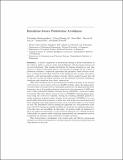Intention-Aware Pedestrian Avoidance
Author(s)
Bandyopadhyay, Tirthankar; Jie, Chong Zhuang; Hsu, David; Ang, Marcelo H.; Rus, Daniela L; Frazzoli, Emilio; ... Show more Show less
DownloadAccepted version (3.315Mb)
Terms of use
Metadata
Show full item recordAbstract
A critical component of autonomous driving in urban environment is the vehicle’s ability to interact safely and intelligently with the human drivers and on-road pedestrians. This requires identifying the human intentions in real time based on a limited observation history and reacting accordingly. In the context of pedestrian avoidance, traditional approaches like proximity based reactive avoidance, or taking the most likely behavior of the pedestrian into account, often fail to generate a safe and successful avoidance strategy. This is mainly because they fail to take into account the human intention and the inherent uncertainty resulting in identifying such intentions from direct observations.
This work formulates the on-road pedestrian avoidance problem as an instance of the Intention-Aware Motion Planning (IAMP) problem, where the human intention uncertainty is incorporated in a principled manner into the planning framework. Assuming a set of all possible pedestrian intentions in the environment, IAMPs generate a Mixed Observable Markov Decision Process (MOMDP), (a factored variant of Partially Obervable Markov Decision Process (POMDP)) with the human intentions being the unobserved variables. Solving the resulting MOMDP generates a robust pedestrian avoidance policy. In spite of the criticism of POMDPs to be computationally intractable in general, we show that with proper state factorization and latest sampling based approaches the policy can be executed online on a real vehicle on road. We demonstrate this by running the algorithm on a real pedestrian crossing in the NUS campus successfully handling the intentions for multiple pedestrians, even when they are jaywalking. In this paper, we present results in simulation to show the improved performance of the proposed approach over existing methods. Additionally, we present results validating experimentally the assumptions made in formulating the intention aware pedestrian avoidance problem.
This work presents a preliminary step towards safer and effective autonomous navigation in urban environments by incorporating the intentions of pedestrians and other drivers on the road.
Date issued
2013Department
Singapore-MIT Alliance in Research and Technology (SMART); Massachusetts Institute of Technology. Computer Science and Artificial Intelligence Laboratory; Massachusetts Institute of Technology. Laboratory for Information and Decision SystemsJournal
Experimental Robotics
Publisher
Springer International Publishing
Citation
Bandyopadhyay, Tirthankar et al. "Intention-Aware Pedestrian Avoidance." Experimental Robotics, edited by Jaydev P. Desai et al., Springer International Publishing, 2013, 963-977. © 2013 Springer International Publishing
Version: Author's final manuscript
ISBN
9783319000640
9783319000657
ISSN
1610-7438
1610-742X